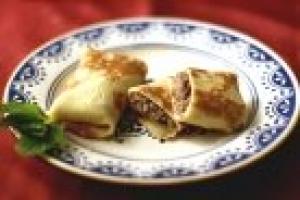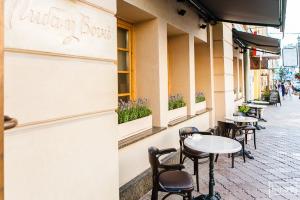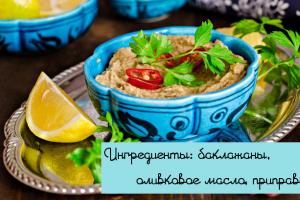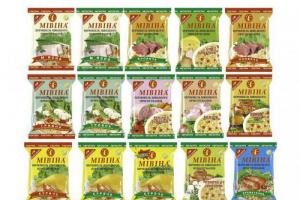Freshly baked buns with butter and jam and coffee with milk - this was the traditional breakfast in Germany. But over time, the Germans began to have breakfast in the fusion style, collecting culinary traditions from different countries.
The birth of the "Hawaiian sandwich"
The Germans began to deviate from the tradition of having breakfast with buns in 1945, when the powers that won the Second World War - the USSR, the USA, Great Britain and France - divided Germany into occupation zones and deployed their military units in them. It was during this period that toasts, which British, French and American soldiers loved to eat, gained immense popularity among the Germans.
Instead of buns, many burghers also began to eat in the morning these slices of wheat bread, lightly fried in a dry skillet or dried in the oven. Some time later, Germany even began to produce special toaster bread. His most popular brand has become and still remains Golden Brot.
Hawaii was the name of a dish invented on that wave in Germany and became a real culinary hit in the 1950s. It was a hot sandwich stuffed with ham, pineapple slice and melted cheese. It is believed that it was under the impression of the German "Hawaiian sandwich" that the Americans later came up with the famous "Hawaiian pizza", which also includes pineapples and ham.
Riding the wave of the "economic miracle"
In West Germany, the 1950s saw an "economic miracle". The country destroyed during the Second World War had to get back on its feet, but there were not enough workers, and the FRG authorities began to fill their deficit by attracting labor migrants from abroad. A stream of guest workers poured into the country from Spain, Greece, Italy, Turkey, Yugoslavia, Portugal. They not only contributed to the well-being of the country, but also expanded the culinary knowledge of the Germans.
So, from Italians, many Germans adopted the habit of eating sweet cookies for breakfast, and thanks to the Greeks and Turks, they fell in love with goat and sheep cheese, olives, cucumbers, tomatoes in the morning. The Spaniards brought to Germany the tradition of serving orange juice and churros with hot chocolate to the morning table. From the Portuguese, the Germans learned to drink a gallon coffee drink for breakfast - a mixture of espresso and hot frothed milk, and to eat miniature puff pastry cakes with a custard filling once invented by Portuguese monks.
Champagne, oysters, muesli, baguette
In the early 1960s, the American company Kellog, a renowned manufacturer of breakfast cereals and instant food products, entered the German market. The first branch was opened in Bremen. The numerous advertising campaigns organized by this brand in Germany quickly paid off: oatmeal and muesli appeared on the tables of the Germans.
In 1971, the first fast food restaurant of the American corporation "McDonald's" opened its doors in Munich. His appearance caused a real stir. On weekends, the Germans began to go there for breakfast with whole families.
Context
In the 1980s, on holidays, Saturdays and Sundays, it became fashionable in Germany to arrange gourmet brunch "in the French way" - with a bite of champagne with oysters, lobsters, cheese of various varieties and slices of baguette.
In the late 1990s, the Germans began to follow the example of New Yorkers - to have breakfast on the go. Mini-coffee shops of the "Coffee-to-go" format began to appear in German cities at every turn. Grab yourself a paper-wrapped sandwich or muffin and coffee in a disposable cup with a lid on your way to work without wasting time making breakfast at home. The American trend quickly caught on in Germany.
But most Germans still prefer to have breakfast at home. Although there is no need to talk about a "purely German" breakfast for a long time. Today, Germans include Swedish salmon, English-style oatmeal, Dutch waffles, and sometimes Russian red caviar in their morning diet. The main thing for them is that the meals served to the table are prepared from the highest quality and environmentally friendly products. A recent study by Nestlé, the world's largest food company, has shown that 76 percent of Germany's residents are closely monitored.
See also:
-
The promising berries came to us from South America. They are said to work wonders in helping you lose weight. But that's not all. Thanks to the high content of antioxidants in acai berries (lat.Euterpe oleracea), you can stop time: avoid the formation of wrinkles, raise the general tone of the body and stay forever slim and young. But this has not yet been scientifically proven.

Photo Gallery: Natural Vitamins for Healthy Success
This fruit is considered one of the most fat-containing. At the same time, the unsaturated fats of avocados (lat. Persēa americāna) have a very beneficial effect on our body, lowering the level of cholesterol in the blood. The pulp of the avocado fruit is rich in vitamins necessary to strengthen the immune system and the nervous system, as well as potassium, which improves heart function.

Photo Gallery: Natural Vitamins for Healthy Success
Chia seeds (lat. Salvia hispanica) are considered to be real "all-rounders". The seeds, completely neutral in taste, are credited with truly magical properties. According to experts, the Aztecs have used chia (or Spanish sage) seeds for food since ancient times. Highly nutritious miracle seed is rich in unsaturated fatty acids (Omega 3, Omega 6), calcium and important trace elements.

Photo Gallery: Natural Vitamins for Healthy Success
Goji berries
Another exotic representative of superfood is goji berries (lat. Lýcium bárbarum), better known as wolfberry, a common non-poisonous relative of wolfberry. The juice made from wolfberry berries has been used since ancient times as a general tonic. Recently, berries have been glorified as "a remedy for all diseases", but there is still no scientific support for this statement.

Photo Gallery: Natural Vitamins for Healthy Success
Grunkol (lat. Brassica oleracea) is a winter type of cabbage, popular in Germany. After the first frost, it acquires a sweetish taste. Cabbage is rightfully considered a real vitamin "bomb": 100 grams is enough to provide the body with a daily dose of vitamin C. In addition, kale contains enough vitamin A, iron and calcium.

Photo Gallery: Natural Vitamins for Healthy Success
Blueberries (Latin Vaccínium myrtíllus) contain more antioxidants than any other fruit and vegetable. An ideal prophylactic agent against colds and cardiovascular diseases, skin allergies. According to experts, this is a great vitamin for our brain. The berries of dark and red colors are slightly inferior to blueberries: currants, blackberries, cranberries, lingonberries ...

Photo Gallery: Natural Vitamins for Healthy Success
The beneficial effect of ginger (lat. Zīngiber officināle) in diseases of the gastrointestinal tract has been known for a long time. This explains the popularity of its use, both in cooking, as a seasoning, and in medicine. Hot tea made from fresh ginger root with a slice of lemon and a spoonful of honey warms and helps to cope with colds and coughs. This is a real elixir of cheerfulness.

Photo Gallery: Natural Vitamins for Healthy Success
There are legends about the benefits of turmeric (lat.Cúrcuma): in India, the plant is considered sacred. It is used as a condiment for almost every dish. The bright yellow powder of dried turmeric rhizome is found in a spice mixture known as curry. Turmeric aids in digestion. In medicine, it is used as an anti-inflammatory and detoxifying agent.

Photo Gallery: Natural Vitamins for Healthy Success
Almonds (Latin Prunus dulcis) have long been considered a very useful product. Almond kernels are not only a popular hunger-satisfying snack. They are widely used in cooking, and the beneficial almond oil is used in the pharmaceutical industry for the manufacture of anti-anxiety and anti-inflammatory drugs. Almonds are believed to help prevent diabetes and Alzheimer's disease.

Photo Gallery: Natural Vitamins for Healthy Success
The grains of the South American cereal plant quinoa (lat. Chenopōdium quīnoa) or quinoa, also called "rice swan", are famous for their high content of protein, phosphorus, iron, calcium and zinc, as well as the complete absence of gluten. In addition, all important amino acids and antioxidants - enemies of free radicals - are included in the nondescript-looking grains.
In fact, there is no such thing as a traditional German breakfast. Breakfast is different in different places in Germany. If in the south in the morning you will be treated to cheeses and sausages, then in the north they will most likely offer buns with jam, honey or nutella. In the old days, meat was the privilege of wealthy southern burghers, and in poor northern lands they made up for the lack of calories than Mother Nature would send. For example, honey or wild berry jam.
Modern Germans usually have both options on the table. Traditionally, these are cold snacks and sandwiches, but always with hot coffee, cocoa or (much less often) tea. Bread and buns must be fresh, only from the oven or from a baker. The Germans leave muesli and yoghurts for weekdays, while on weekends they indulge in delicacies.
In short, the recipe for a "German breakfast" is simple: more cheese, sausage and meat delicacies, and fresh aromatic coffee. But if you have some free time on Saturday morning, bake these muffins for real men:
Man's muffin recipe
Ingredients for 6 pieces:
- 6 slices of bacon;
- 6 eggs;
- salt, ground pepper;
- 1 tbsp. l. oils for lubrication.
- Grease muffin tins with oil. Place a piece of bacon in a circular pattern along the sides. Break the egg in the center. Add salt and pepper to taste.
- Put in an oven preheated to 160 degrees for 10-12 minutes or until the eggs are ready.
- Place muffins on a plate and sprinkle with chopped green onions.
Breakfast of the "Living Berlin" club
a) you do not know how to cook anything more complicated than a sandwich;
b) or love, like us, to cook in a big and fun company;
c) or just missed interesting people,
Come on Saturday, December 9th, to our "homemade" breakfast of the "Living Berlin" club. This time we will cook our own goodies.
Cooking: Plätzchen traditional German holiday biscuits and Advent breakfast snacks.
We tell: our "kitchen" stories, for example, how they feasted on the nastiest fruit in the world or cooked a bat consommé.
And as always, you are in a good mood and funny stories, with us - live communication, interesting and useful acquaintances, new friends, unexpected ideas and, of course, delicious treats.
2. Bavarian breakfast
Compared to all other German breakfasts, both sweet and meat, the Bavarian breakfast stands out. Well, who else, besides the Bavarians, would think of replacing morning coffee with morning beer? It's over, this is not a weekday breakfast. But if you have to, why not start the morning with a glass of Weizen?
So, a traditional Bavarian breakfast consists of one white sausage with sweet mustard, one fresh kalacha pretzel and one glass of light wheat beer. And you can repeat it as many times as you like, until lunch comes. Then it doesn't hurt to eat something more serious, for example, baked pork shank with stewed cabbage.
How to cook white bavarian sausages properly
The main secret of making white Bavarian sausages is that you don't need to cook them !!!
- Boil a pot of water and remove from heat.
- Gently dip the sausages in hot water. Close the lid and let it warm up for 10-15 minutes.
- Serve in the same saucepan. When using, take out one at a time so that the rest do not cool down.

Photo: pixabay.com (CC0 Public Domain)
3. Peasant breakfast
No matter how hard the life of the German peasants was, their breakfasts have been good for a long time. How else, if you then harness, plow, milk, mow all day until sunset? And it is not a fact that in the process it will happen again with feeling, with sense, with an arrangement to kill the worm. Therefore, in the morning it was supposed to refuel for the whole day. And here there is no time for delights, delicacies and porcelain plates with silver spoons. What is ripe in the garden and has grown in the barn, that and are glad: in a frying pan and in your mouth, oops!
Like hundreds of years ago, at six o'clock in the morning in some Höchenschwand (Baden - Württemberg), the whole family gathers at a large wooden table: the owner, the hostess, the children, the old father. The hostess brings fresh eggs from the chicken coop, finely chops the onions, meat scraps and potatoes left over from yesterday's dinner, mixes and shakes them in a frying pan, makes coffee, and serves a large round loaf on the table. The men, meanwhile, are leafing through the newspapers.
The main ingredients of the peasant breakfast are potatoes and eggs, the main sources of energy. Onions, meat, ham and smoked meats add flavor. A luxurious omelet is made from these simple products in an old frying pan, or even better in the oven. Such a breakfast, however, cannot be called dietary - it contains half a thousand full-weight calories per 100 grams.
Such omelets are popular not only in Germany. French and Swedish farmers also serve them in the morning before going to milking. And the Spanish tortilla is nothing more than an omelet with onions and potatoes.
Peasant style omelette recipe
Ingredients for one serving:
- 2 boiled potatoes;
- 2 eggs;
- 1 small onion;
- 80 g lard with meat or fatty ham;
- 1 bunch of green onions;
- 50 ml of milk;
- 1 tbsp. l. oil or fat for frying;
- salt, ground pepper.
- Peel and chop the onions, chop the green ones. Dice the ham or lard. Potatoes - in circles.
- Beat eggs with milk, salt and pepper.
- Heat a frying pan and melt butter in it. Fry the ham briefly, add the onions. After a few minutes, put potatoes in the same place and fry until golden brown, turn over and add green onions.
After a minute, pour eggs whipped with milk. Reduce the temperature, close the lid and fry until tender.

4. Berlin style vegan breakfast
To paraphrase popular wisdom, what is good for a Bauer (a peasant) is death for a hipster. We will delight those who do not want to see meat, eggs and milk on their table. Every day, vegetarianism and veganism are gaining more and more popularity. But this does not mean that you chew one celery for breakfast. Muesli, smoothies, beetroot and avocado pâté, cereals ... What about ersatz scrambled eggs?
Recipe for vegan scrambled eggs with mushrooms
Ingredients:
- 250 g tofu;
- 2 medium mushrooms;
- 1 tomato;
- 1 small onion;
- a few feathers of green onions;
- turmeric;
- black Asian salt, ground pepper;
- vegetable oil for frying.
- Cut the tomato and onions into cubes, the mushrooms into slices.
- Heat oil in a skillet. Do not chop the tofu too finely, fry and add turmeric for an egg color.
- Add chopped vegetables and mushrooms, fry until tender.
- Season with black salt, pepper and sprinkle with chopped green onions.

Photo: pxhere.com (CC0 Public Domain)
5. Advent breakfast (not to be confused with Advent)
This is a four-week pre-Christmas period, waiting time and preparation for the holiday. By the beginning of Advent, it is customary to decorate the house, decorate the table with candles, golden stars, spruce branches, and give children with sweets.
Advent Sunday breakfasts hold a special place in the hearts of many Germans. These are big family get-togethers with Christmas paraphernalia, music, decor and traditional goodies. On the table, there must be Christmas pastries: Christmas trees and snowflakes. In addition to traditional coffee and cocoa, Germans on Advent like to brew aromatic teas, the smell of which alone creates a festive mood.
You won't understand any country if you don't taste the national cuisine.
Like you and me, it is customary for the Germans to eat 3 times a day - breakfast, lunch and dinner.
For breakfast, they prefer to drink coffee with milk or tea, eat a freshly baked bun with jam, scrambled eggs and bacon or sausage. Breakfast is early, from about 7 to 8 in the morning. I must say that the Germans pay special attention to baking, they like to cook homemade pies and rolls.
Frühstück - breakfast
zum Frühstück - for breakfast
Lunch also differs little from the average European. From 12 to 14 o'clock, it is customary to enjoy soup and necessarily meat with potatoes, vegetables or salad, or try meat scraps, shmorbratin, snellklops, Hamburg-style steak.
Soups are prepared with fish or meat, potatoes and lentils, even nettles. Gourmet soup with snails is common in the south of the country, while eel soup is made in the north. Bread and beer soups are popular.
It should be noted that vegetables in a wide variety of forms are held in high esteem by the residents of the republic - they eat boiled, raw, fried vegetables, but sour cabbage, which tastes a bit like the familiar sauerkraut, is worthy of special attention, but has its own unique taste. The national German dish is potato salad.
Unlike the "fish Thursday", which was adopted in Soviet times in our country, in Germany people like fish for lunch on Fridays.
The portion sizes are very surprising, with one portion of a German dish in our country, 2 or 3 people would be fed.
Young people in today's rapidly changing life, especially in Berlin, often run into fast food establishments for a bite to eat. Here they buy different sausages with mustard, chicken or the very beloved Denar Kebab, which is made from beef.
Mittag, Mittagessen - lunch
Essen - official lunch
For dinner, the Germans eat the least, mostly quick sandwiches with cheese, ham, sausage, butter and fish.
Abendessen, Abendbrot - Dinner
beim Abendessen - at dinner
Beer is considered to be a traditional drink; Germany is even called the country of beer madness. The popularity of the intoxicating drink has led to the organization of numerous beer festivals, the most popular of which is Oktoberfest in Munich.
German beer houses (Kneipe) can be considered a library of German cuisine, in addition to beer, you can taste pork knuckle, chop, meatballs, potatoes and salads, dumplings, deep-fried ribs
A small piggy bank of German cuisine:
Kotelett - chop chop
Klops - bits
Currywurst - fried sausage with curry sauce
Berliner Weisse - a weak Berlin white beer with syrup, a real dessert for the locals
Brezel - pretzel
Suppe - soup
Fleischsuppe - meat soup
Eintopf - a thick soup that's considered a complete lunch
Sauerkraut - sauerkraut
Brötchen - bun, loaf ein belegtes Brötchen —
a sandwich ( with sausage, cheese, etc.)
ein süßes Brötchen —
bun
Pfannkuchen - Berlin style pancakes with marmalade inside
Bratwurst - grilled sausage, grilled sausage
Eisbein - boiled pork knuckle
Hackepeter - A snack made from raw minced meat with egg, salt and seasoning, usually spread over bread
7 am, a sleepy rainy morning, I am sitting in the kitchen of my German friend Jonas. At this time, getting out of bed and crawling to the kitchen is already a feat for me. Without coffee and an invigorating soul, the brain refuses to work and perceive reality.
Refuses to understand a) how I was raised for breakfast so early (indignantly!), B) how so Jonas has already managed to go to the shower, dry up, get dressed and even buy fresh bread for breakfast! More precisely, not bread, but delicious buns or Brötchen, still warm, fresh from the oven, bought from a neighboring baker ( Bäcker) nearby ...
It is sometimes difficult for a Russian person to understand this (why bother, because there is also bread that I bought yesterday, and in general there is a lot of food in the refrigerator, why else should I go somewhere else to buy something now, I’d better sleep for half an hour longer), but frische Brötchen(yes, those very fresh buns!) This is a special kind of cult among the Germans. The bread must be fresh and of good quality. I pick up one loaf or one bun, not even knowing how to call it correctly and am surprised how many different seeds are on top and how delicious it all smells and - mm ..! how delicious it is! At home, I always ate everything without bread, but even I cannot refuse these buns. Jonas shares a secret with me: you shouldn't buy bread in the supermarket (it's a quality issue), and even more so in advance (otherwise it won't be fresh anymore!). The only thing you can buy in advance in the supermarket Brötchen zum Aufbacken, which can then be reheated and cooked at home in the oven, but best of all are fresh, fresh from the bakery.
So, Brötchen relies on breakfast here. And what else? Jonas takes strawberry and apricot jams from the fridge ( Konfitüre( mit Kräutern) - it's all " Aufstrich»: What is spread is put on top of the bread. Then a few yoghurts and milk are taken out of the refrigerator, and a box of cereals and muesli migrates from the next cabinet to the table. Jonas prepares coffee: he has a special machine in his kitchen: you choose what and how much you want, pour water, put a special bag with a coffee filter inside, press a button and in a minute the kitchen is filled with an awakening coffee aroma ...
While I drink my coffee, Jonas says that their family also has breakfast ( zum Frühstück) there is a boiled egg, and on Saturdays or Sundays - scrambled eggs with slices of tomato and bacon. Many people drink coffee with a croissant, but this is not a German tradition, he says. But yogurt for breakfast - yes, and also muesli. Hearing that in Russia, in schools and kindergartens, children are often forced to eat porridge for breakfast and soup for lunch, Jonas frowns and says that he hardly ever eats soups at all and for him the only possible liquid soup is Buchstabensuppe, in which instead of noodles and vegetables, different letters of the alphabet from the dough float, but this comes from childhood. Then, after thinking a little, he adds: well, there is still Milchsuppe(milk soup), Linsensuppe(soup with lentils) ... and, beaming, adds: and there is also Borschtsch!
 Germans really don't eat soups that often, and their soups are either cream soup (like French champignon or cheese soup or Spanish gazpacho) or hearty Eintopf, which replaces both the first and second course - something like a very thick soup with the addition of legumes, peas, beans or lentils, potatoes, pieces of fried sausages or meat.
Germans really don't eat soups that often, and their soups are either cream soup (like French champignon or cheese soup or Spanish gazpacho) or hearty Eintopf, which replaces both the first and second course - something like a very thick soup with the addition of legumes, peas, beans or lentils, potatoes, pieces of fried sausages or meat.
Also, says Yonas further, for lunch (zum Mittagessen) be sure to eat hot. A large piece of schnitzel with mashed potatoes, or chicken fillet with a side dish and vegetables, potato casserole and meat goulash - everything is very satisfying and dense. Therefore, it is not surprising that after such a hearty dinner, many people like to drink a cup of espresso. „Zur Verdauung"(for" digestion ") and sit on the couch to take a nap ( ein Schäfchen or ein Nickerchen machen).
At 16 o'clock the time comes „ Kaffee und Kuchen"when it's nice to have a cup of coffee with milk and eat a slice of fresh pie. German pie ( Kuchen) is not exactly the same as a Russian pie, and even more so it has nothing to do with grandma's pies! This is most likely something in between a pie and a cake, made from the most delicate biscuit or shortbread dough with the addition of various fillings - strawberries, cherries, plums, apples or curd-creamy mass ( Käsekuchen). It is also interesting that in Germany cottage cheese ( Quark) belongs to a number of soft cheeses and is often eaten not as a sweet dish in Russia with jam, but with the addition of herbs, herbs and eaten with potatoes or bread. At the same time, the German Quark is also distinguished by its consistency - it is not grainy, but in the form of a homogeneous thick creamy mass.

What do they eat in Germany for dinner? - Jonas replies that it is difficult to give any one answer here, because everything will depend on everyone's taste habits and which restaurant you were invited to zum Abendessen- Italian, Japanese or Greek (by the way, the Germans usually speak not to an Italian restaurant, but to an Italian, etc. - zum Italiener, zum Japaner, zum Griechen etc, meaning a specific restaurant known to both and its owner is Italian). Many agree after work with friends, colleagues or business partners to have dinner somewhere together. If you were invited to dinner at your home, and not in a restaurant, and they also cooked specially for you, you can consider this a sign of special disposition and attention. It is also considered a sign of special attention when a young man invites a girl to have dinner at an expensive restaurant (at his expense in this case, of course!) - so, instead of flowers and compliments, they try to impress.
Compared to some other European countries - Spain, Italy, Portugal, in Germany they dine quite early, on average at six or seven in the evening. Dinner is also called not only Abendessen, but also Abendbrot so don’t be curious if somewhere in the hotel they offer you for dinner ... bread - with some kind of sliced bread and a salad of vegetables or something like that. Many people explain this by the fact that one warm meal a day at lunch is quite enough, and besides, it is harmful to eat fatty or heavy food at night. - Well, yes, because they go to bed in Germany quite early, too, considering what time everyone gets up here! Lessons at school often begin as early as 7:30 in the morning, and the bus to school from some village leaves 40 minutes before that, so this is what time poor mother needs to get up to cook breakfast for her children and collect and send them to school ...
I look at the clock - the time is twenty minutes past seven. In five minutes, Jonas has to run to the bus stop to catch the tram to the first pair to the university, which starts at 8 am. He quickly pours himself coffee into a thermos, wraps a few Brötchens in foil to take with him, grabs a backpack, keys, a scarf, and a moment later disappears into the hallway.
Mach's guuuut!- his farewell is heard from the door. Bis heute Abend!- I shout after me and, putting the cup in the dishwasher, I go to watch my dreams. Because today I don't need to run anywhere so early.







